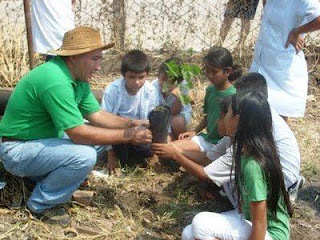![]()
 |
| Environmental education for children, for a Reforested Ancon |
Trees act as huge lungs in cities.Through the process of photosynthesis, they capture carbon dioxide (CO2) from the atmosphere and release oxygen, which is necessary for the life of the rest of living beings.
CO2 is one of the greenhouse gases, so increasing the number of trees on the planet helps reduce the amount of gases responsible for climate change that inevitably leads to global warming.
These are 7 reasons why you should plant trees and help reduce the impact that our “development” actions have on the planet.
- Trees reduce pollution.
The leaves of trees retain dust particles floating in the air, preventing us from inhaling them when we breathe.
Plant trees in rows, this way they will act as a barrier against particulate matter in the atmosphere.
- They oxygenate the air.
The leaves fix atmospheric CO2, which is a waste product of human and animal metabolism and fuel burning, in addition to producing large quantities of O2 necessary for life.
- They refresh the environment.
In addition to photosynthesis, plants develop other processes such as evapotranspiration.
Leaves release water vapor that cools the air and humidifies it. If you plant trees around your house, you can cool it by 10% to 50%. This way, you will reduce the use of cooling systems that also pollute the environment.
- They reduce noise pollution.
The large masses of leaves act as buffers against the noise generated by traffic, industries and the functioning of the city.
- They are small ecosystems.
Each tree functions as a true ecosystem, with birds, insects and sometimes other plants living on it and interacting with each other. When a tree is cut down, hundreds of other living beings that inhabit it disappear.
- They intervene in the water cycle.
The roots retain rainwater, allowing it to slowly filter through the soil to the aquifers and then slowly flow to the rivers, keeping the flow stable and preventing droughts and floods.
- They protect the soil.
They prevent soil erosion and wear by "holding" soil particles with their roots.
You can read other articles of interest at Responsible Citizen
